A Moment in Time: To Create a Partnership
Richard Weingroff / FHWA News 2022
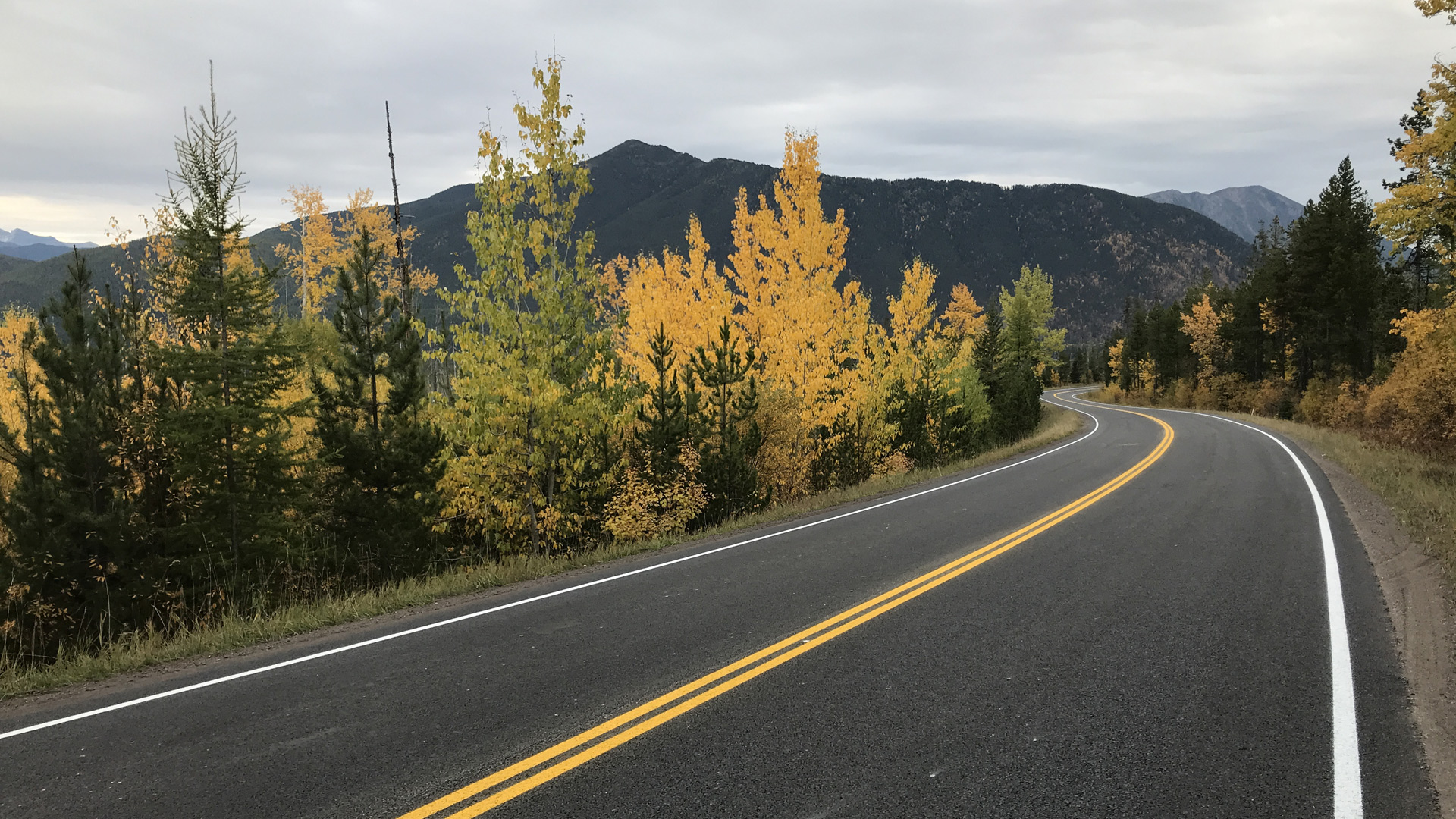
On November 17, 2021, Secretary of Transportation Pete Buttigieg and Secretary of the Interior Deb Haaland toured an active trail construction project overseen by FHWA's Eastern Federal Lands Highway Division in Rock Creek Park that will improve safety and access for pedestrians and bicyclists. The project is adding a protected tunnel and enlarging and enhancing green space on the multi-use trail next to the Rock Creek and Potomac Parkway, by widening.
The main purpose of the visit was to sign a Memorandum of Understanding (MOU) to strengthen the longstanding mutually beneficial relationship between the Interior and Transportation Departments and to improve access to and transportation within facilities overseen by the National Park Service (NPS) in view of rapidly evolving advancements in technology and innovation. Work under the MOU is to demonstrate and incorporate new stand-alone and/or complementary technologies in park operating environments to help NPS develop a transportation system that is compatible with its resource protection mission, while also giving visitors enhanced access for car-free trips, and educational and enjoyment opportunities.
Secretary Buttigieg said the joint initiative would "keep our most prized national wonders accessible and safe for all Americans." Secretary Haaland explained that, "As our national parks and public lands experience a surge of visitation, we must be innovative in our approaches to welcome people from every ZIP code, while also ensuring that we pass on these natural and cultural resources to future generations." The partnership between the two Departments would help advance "innovations and access to public spaces."
The MOU was only the latest enhancement to a partnership that began in the 1920s. A moment in time on July 15, 1933, in Glacier National Park, best symbolizes the start of the partnership between NPS and FHWA.
Early Collaboration
In 1905, Congress transferred the country's forest reserves from the Department of the Interior to the Department of Agriculture, which housed our predecessor agencies from 1893 to 1939. As the need for forest roads evolved, the agency with expertise in road building was called on to help an agency now in the same department meet its road building needs. Early on, our agency constructed a macadam road to the Weather Bureau Station in Purcellville, Virginia; investigated the roads and trails in the Yellowstone Forest Reserve surrounding Yellowstone National Park, and provided advice on wagon roads and trails to aid lumbering. Funds for roadwork came from 10 percent of revenue for timber harvesting, livestock grazing, and other commercial activities.
In February 1914, Director Logan W. Page of the U.S. Office of Public Roads (OPR) established a Division of Park and Forest Roads, with senior engineer T. Warren Allen as chief. At a time when the U.S. Army Corps of Engineers (USACE) was the primary source of engineering expertise for the National Parks, the goal was to give advice on road needs in National Parks as well as National Forests and to supervise major construction projects.
From 1913 to 1915, Allen spent considerable time in Yosemite, Glacier, Sequoia, and Mount Rainer National Parks working on surveys and road plans. In 1915, he told a National Park Conference, "I, as a road builder, have dreamed of road development in the various parks, and have dreamed of seeing such roads, lined and banked with flowers which grow wild in the meadows of the parks and upon the mountain sides, winding unassumingly along the brook, beneath the water fall, and skirting timidly the majestic mountain." OPR had constructed 170 miles of park roads, maintained 160 miles, and had plans for 477 additional miles.
On July 11, 1916, President Woodrow Wilson signed the Federal Aid Road Act establishing the Federal-aid highway program that, with changes over the years, FHWA administers to this day. Section 8, however, authorized funds for a $1 million-a-year, 10-year program of road building in National Forests (1917-1926). OPR would have a major forest program to administer for years to come, but its park road work would soon come to an end.
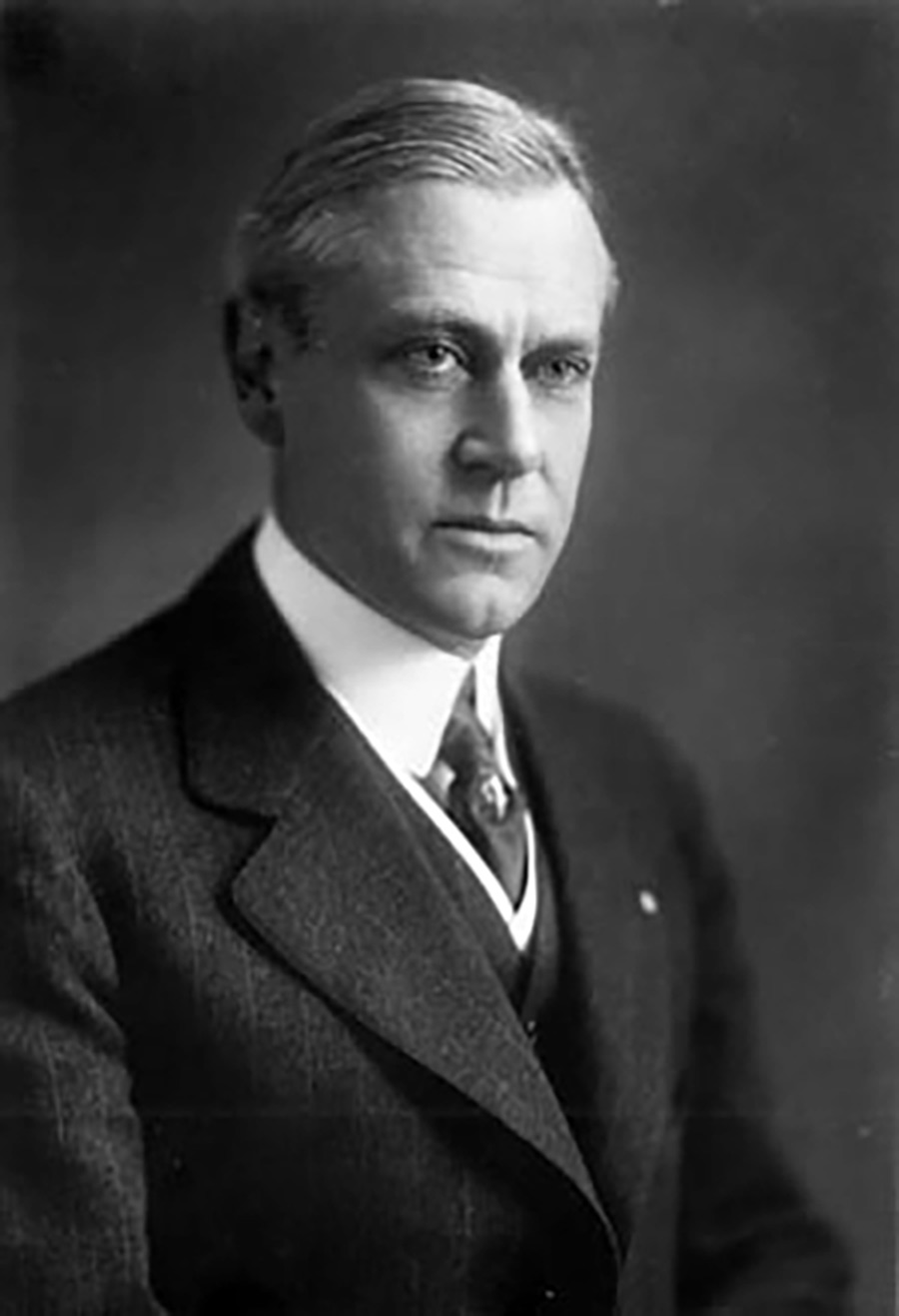
A little over a month later, on August 28, 1916, President Wilson signed legislation establishing NPS in the Interior Department. Its first Director, Stephen T. Mather, took office on May 16, 1917. He had worked hard to create NPS.
Soon after creation of NPS, Interior Secretary Franklin Lane issued a statement on park management. Recognizing the need to accommodate the growing number of autos accessing the parks, he declared that, "In the construction of roads, trails, buildings and other improvements, particular attention must be devoted always to the harmonizing of these improvements with the landscape." NPS should employ "trained engineers who either possess a knowledge of landscape architecture or have a proper appreciation of the aesthetic value of park lands." All plans should be designed for "the preservation of the landscape."
Mather wanted to retain control of all park features, while NPS officials were skeptical that OPR engineers had the requisite affinity for park values. NPS, Mather thought, should have civil engineers to work with its landscape architects. As a result, NPS would soon neglect its brief partnership with OPR, which became the Bureau of Public Roads (BPR) in 1918.

In 1917, Mather borrowed George E. Goodwin of the USACE to serve as Chief Engineer for road work in the National Parks, a post he would hold into 1925. Although Goodwin was a skilled road engineer who worked within NPS budget realities, he often defied NPS's policy on the harmony of the roads with the landscape. As NPS historian Timothy Davis pointed out, Goodwin believed that "conspicuous feats of road construction complemented nature's grandeur and afforded appealing spectacles in their own right." In addition to being "supremely confident in his abilities," he "had a reputation for being arrogant, dogmatic, and disputatious."
Given the focus stemming from Section 8 of the 1916 Federal-Aid Road Act on forest roads, trails, and bridges, OPR Director Page replaced the Division in 1917 with the Office of Road Construction and Maintenance to focus on the expanding forest work.
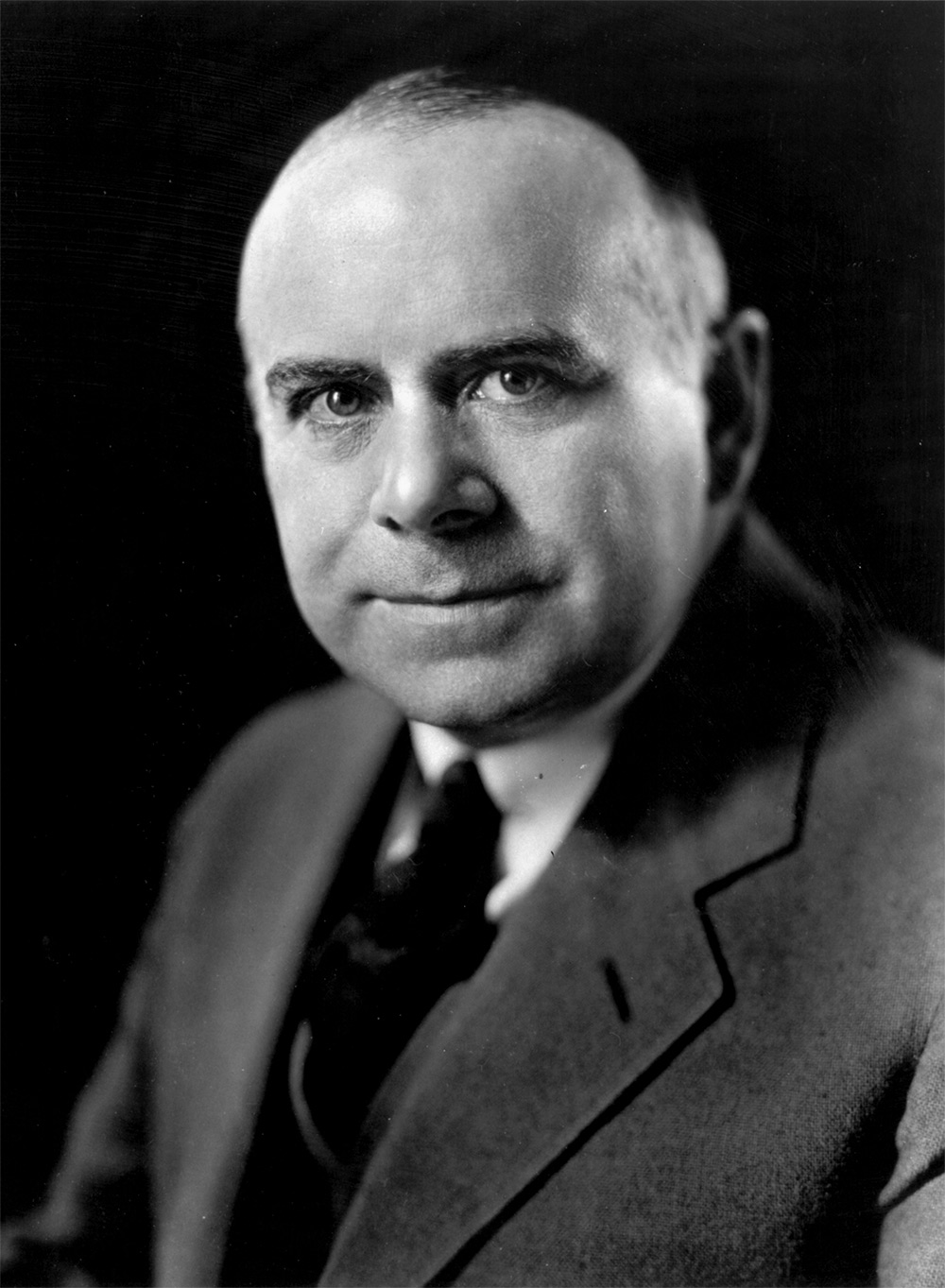
Page's successor in 1919, Thomas H. MacDonald, approached NPS in the early 1920s about taking over road responsibilities in the parks, but was rebuffed because Mather worried that BPR would not approach the work with park values in the forefront.
Transmountain Highway
The problems with Goodwin came to a head during development of the Transmountain Highway in Glacier National Park – a problem that brought NPS and BPR together again.
The goal was a road across the Continental Divide in some of the most rugged terrain in the northern Rocky Mountains – without marring the landscape. OPR's Allen had visited the park in 1914, advising that Logan Pass was the best option for crossing the Divide. He recommended a grand loop that would allow visitors to reach a wide array of the park's attractions. However, several other concepts were under consideration by the time Mather took over NPS.
Goodwin's design called for the construction of fifteen closely spaced switchbacks to minimize construction costs while maintaining a reasonable grade up the steep ascent to Logan Pass. He began construction in 1918 after completing an early design for the Transmountain Highway that crossed the Divide at Logan Pass. The starting point would be at an elevation of 3,537 feet and rise to an elevation of 6,648 feet. The location was accessible only by pack horses. With funds limited, Goodwin was able to complete only 8 miles by the summer of 1924, but park road work was about to increase considerably.
On April 9, 1924, President Calvin Coolidge signed legislation authorizing $7.5 million for NPS to use over 3 years for park roads. NPS now had twice as much funding for park roads as had been appropriated in the entire history of the National Parks. The legislation also earmarked funds to advance the Transmountain Highway.
By then, Goodwin's plan was considered technically outdated and at odds with the goal of preserving landscape values. The plan included too many switchbacks approaching Logan Pass to avoid grades too steep for traffic. As NPS assistant landscape engineer Thomas C. Vint put it in 1924, the result would end up "looking like miners had been in there." He told Mather that "this job is important enough for you to hire the best engineer and the best landscape architect in the country to look after." Mather turned to BPR Chief MacDonald for help in conducting a survey to improve the link. MacDonald saw it as an opportunity to show what his agency could do.
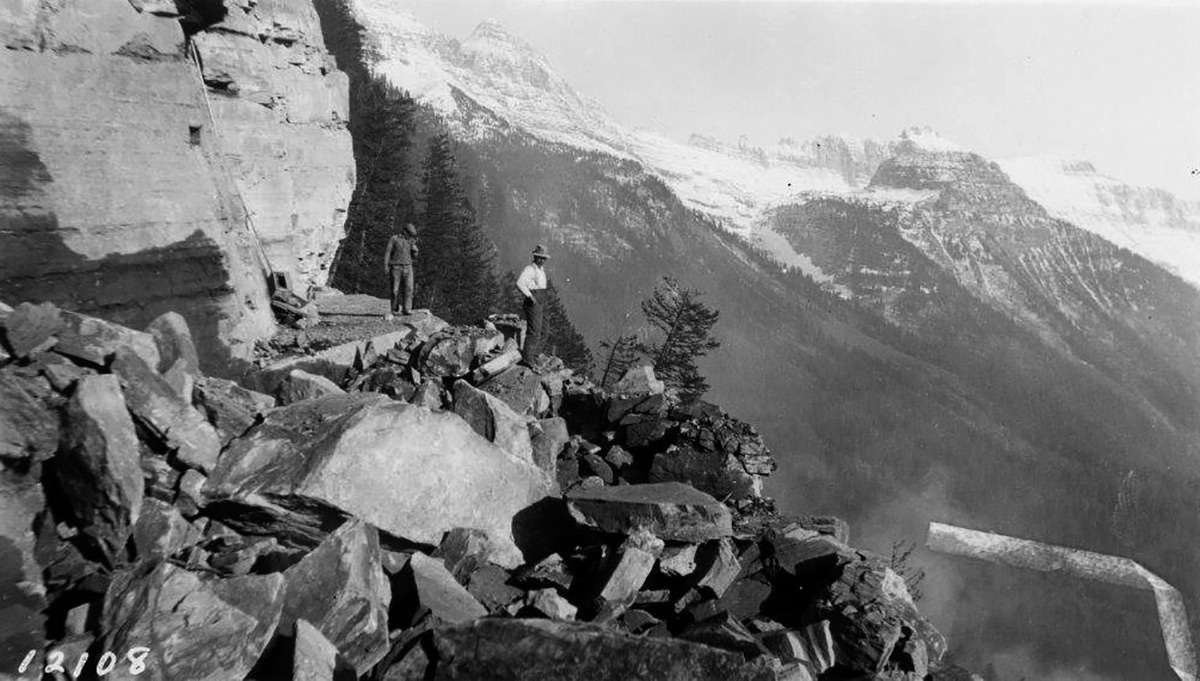
The First MOU
Frank Kittredge, BPR's Senior Highway Engineer, arrived on September 11, 1924, to direct a survey that mapped 21 miles over the Continental Divide, as his team raced to complete the work before winter closed in. An NPS history stated that, "Kittredge and his team of 32 men often climbed 3000 feet each morning to get to survey sites. The crew walked along narrow ledges and hung over cliffs by ropes to take many of the measurements. The work was too challenging for some, and Kittredge's crew suffered from a 300 percent labor turnover in the three months of the survey." The resulting grade was 6 percent lower, with wider curves that would be easier for motorists to navigate while reducing the road's visual impact on its spectacular surroundings.
Kittredge's skill, and his understanding of the scenic values of the highway, convinced Mather and his team that a partnership with BPR was the best option for constructing a high-quality road. Further, Mather was concerned that NPS's limited staff might not be able to handle the dramatic increase in park-related road projects around the country. He directed Superintendent Charles Kraebel of Glacier National Park and Vint to work with BPR on a formal working agreement for the Transmountain Highway and other NPS projects. As Davis pointed out, funding was another factor. "MacDonald pushed – and Mather believed – that the BPR's success in garnering large appropriations would translate to more money for park roads."
Mather and MacDonald approved the agreement, which was completed on February 10, 1926, covering the survey, design, construction, and improvement of roads and trails. It asserted that NPS, "in the interest of economy and efficiency, desires to utilize the services of the existing road-building organization of the Bureau of Public Roads in the survey, construction, reconstruction, and improvement of roads and trails within the national parks and national monuments." The first article specified that NPR and BPR "shall use every effort to harmonize the standards of construction of roads and trails in the national parks and monuments with the standards adopted for the construction of the roads which form a part of the Federal Aid Highway System and of roads and trails within the national forests and to secure the best modern practice in the location, design, construction, and improvement thereof."
NPS would initiate projects, but BPR would conduct surveys in cooperation with NPS landscape architects, who issued stringent guidelines for landscape preservation and retained ultimate authority over all decisions. NPS would program funds, and undertake minor projects, but for major projects BPR would supervise contractors. Landscape architects would inspect and supervise construction of bridges and guardrails to ensure preservation of natural features. The agencies agreed to "use every effort" to harmonize construction standards on parks and monuments with the standards adopted for the Federal-aid highway program.
The agreement, as updated over the years, still governs the NPS/FHWA collaboration.
Construction Underway
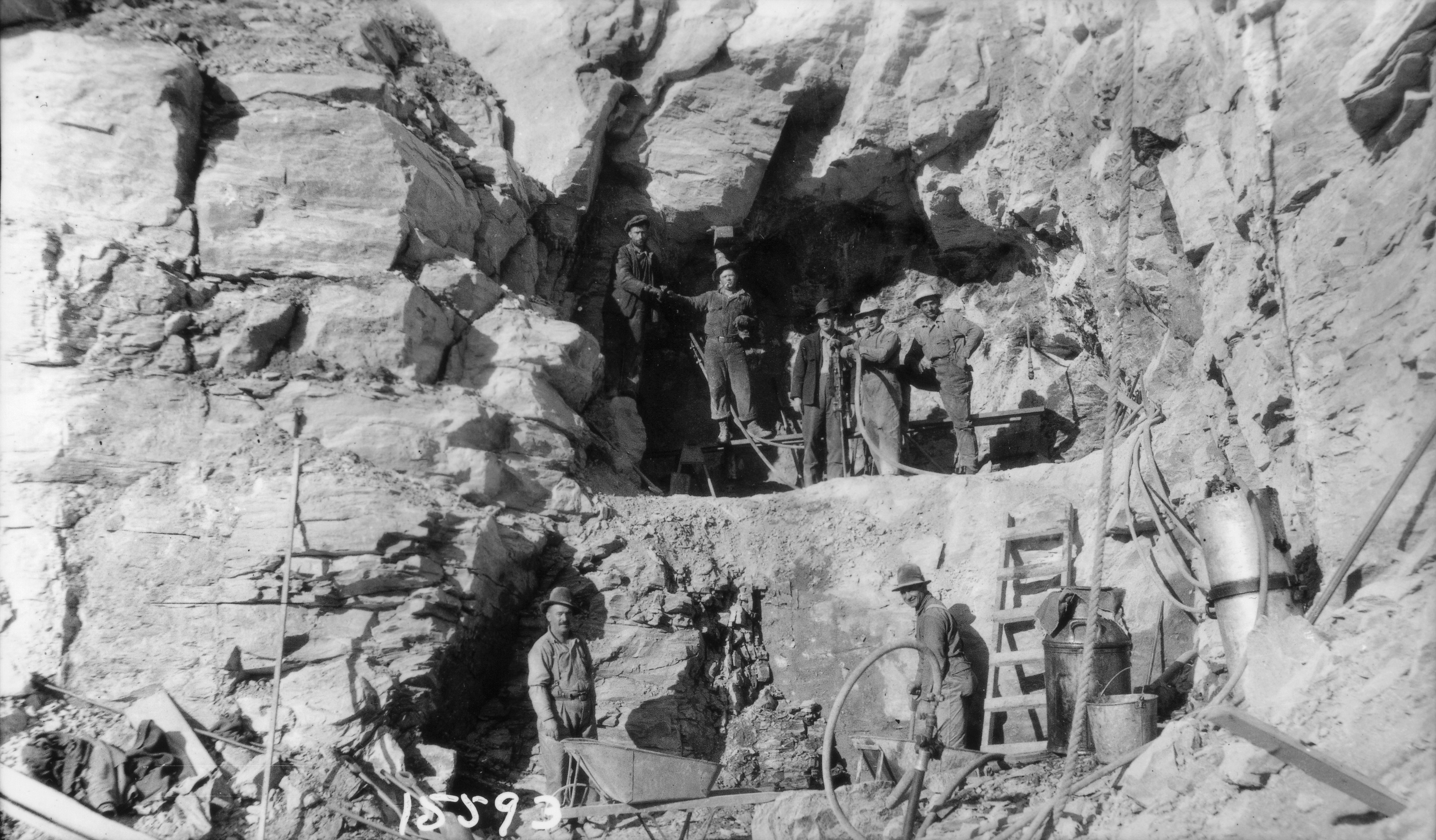
MacDonald, in BPR's 1927 annual report, called the Transmountain Highway one of "the most interesting of the national-park projects." He wrote, "Here is a road in which practically every conceivable obstacle has been met and overcome." The 16-foot road was "being literally hewn out of the solid rock of the Garden Wall in order to reach and cross the Continental Divide."
Even before the agreement, construction resumed in 1925 with BPR supervising contractors. Problems soon developed as BPR's contractors neglected stipulations designed to protect the park landscape, letting excavated material roll down the mountain to destroy vegetation, and ignoring NPS's detailed instructions on explosions. While putting most of the blame on the contractors, NPS concluded that BPR was not doing enough to enforce contract provisions.
In June 1926, Glacier Park Superintendent Kraebel explained, "Our friends of the Bureau are essentially road builders, dirt movers, rock blasters, [and] surfacing experts. They are only beginning to learn what the Park roads require in the way of landscape protection." He warned, "We are not safe in giving them too free a hand."
Despite the dangers facing workers and NPS's concerns about impacts on the landscape, BPR's contractors finished the section between Avalanche Creek and Logan Creek in 1925, and the final 12 miles on the west side, Logan Creek to Logan Pass, by October 1928. When the 3-year funding cycle ended, much work remained, but the economic downturn following the stock market crash in October 1929 prompted Federal austerity measures that put the project on hold.
Funds finally became available in 1931 for the last 10 miles between Logan Pass and St. Mary Lake. Crews went back to work that year on the east side of the Transmountain Highway. The work included a 405-foot tunnel and other heavy rock work, but also an easier descent to the road leading to East Glacier. BPR Engineer Jean Ewen wrote, "Our only prayer must be that our work may be truly a component part of this wonder of nature, that we may not have marred that which we, with our science, knowledge, and experience, could never reproduce."
About That Name
With completion in sight, the descriptive but dull name Transmountain Highway was seen as uninspiring for such a magnificent road. Where the new name came from is uncertain, but by 1933, it had become the Going-to-the-Sun Road in time for the opening ceremony on July 15, 1933. Construction had spanned two decades and cost more than $2 million.
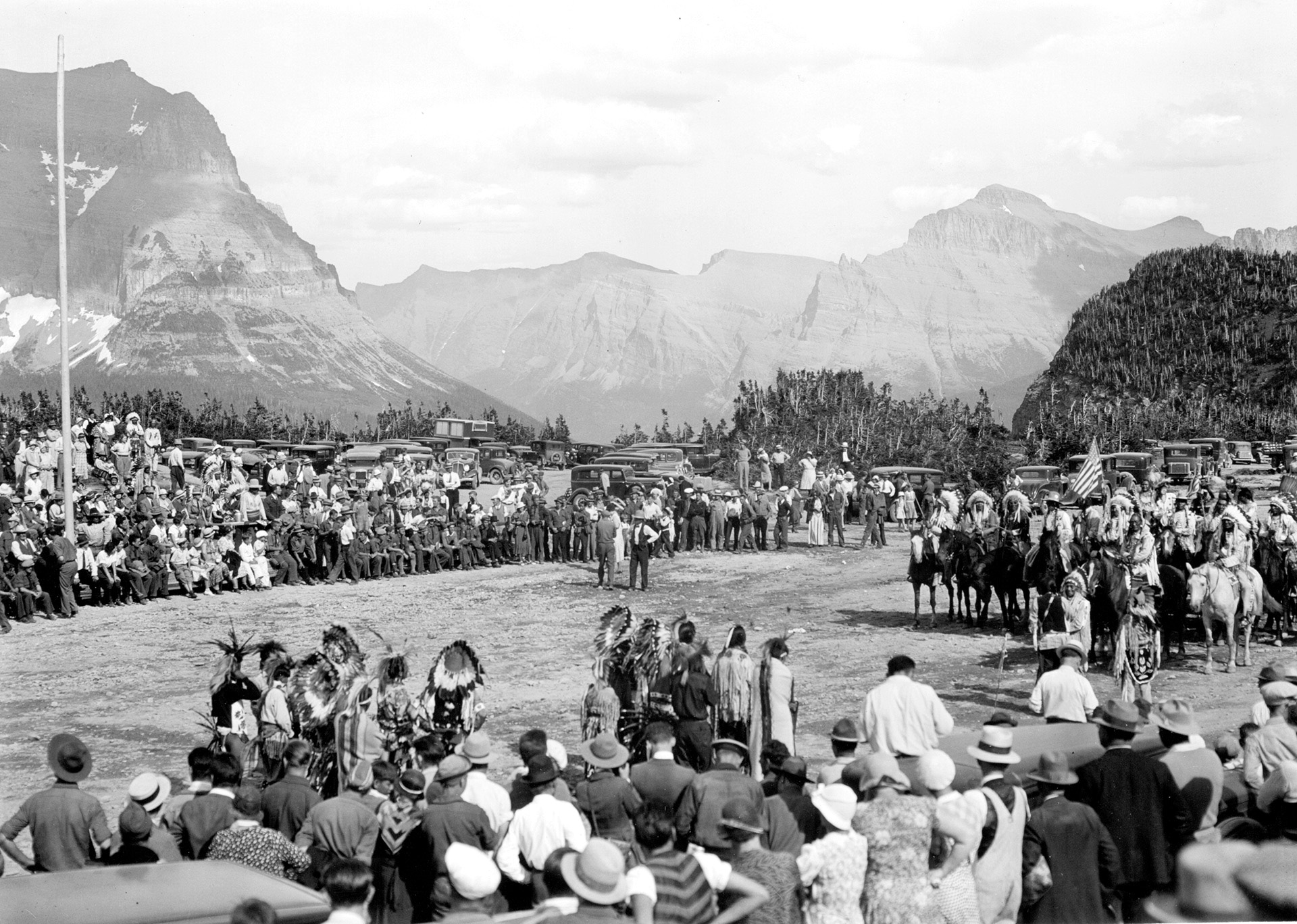
The ceremony at the Logan Pass summit of the continental divide 6,654 feet above sea level attracted 4,000 people. Glacier National Park Superintendent Elvind T. Scoyen, as chairman, read messages from those unable to attend, including Interior Secretary Harold L. Ickes who called the road "a magnificent job perfectly accomplished." He acknowledged the challenges. "Workmen who risked their lives daily on the faces of the steep cliffs that had to be conquered to make this modern trail deserve special honor for their share in the great undertaking."
NPS Director Horace M. Albright, also unable to attend, sent a message that recalled how in 1915 and 1916, he "rode the trails of Glacier National Park with Mr. Mather, and as we rode, we discussed routes for the highway you are dedicating today." Albright was particularly pleased that on that day, "you are dedicating a memorial to Mr. Mather," who after a paralyzing stroke in November 1928 had retired on January 8, 1929; he died on January 22, 1930. The highway would fill the need "to see the glory of Glacier's peaks and crags, and the hanging gardens of wild flowers." Within the park, "Let there be no competition of other roads with the Going-to-the-Sun Highway. It should stand supreme and alone." It exemplified NPS's policy of limiting development, balancing preservation and access to the minimum amount of high quality road, and leaving the majority of parks free from development.
Also absent was Chief MacDonald, whose telegram stated that the road was BPR's "first national park highway" for NPS. He added that "the conception and development of this remarkable scenic highway now stands as a joint achievement of the two services which I am confident will prove to be a very necessary utility and the source of worthwhile delight to an ever-increasing public."
The ceremony included the unveiling of a bronze plaque honoring Mather at the summit of Logan Pass. It stated, "He laid the foundations of the National Park Service, defining and establishing the policies under which its areas shall be developed and conserved in care for future generations. There will never come an end to the good he has done."
BPR's A. V. Emery, who supervised construction of the east side of the highway, talked about the challenges faced, particularly on the section from Trapper Creek to Logan Pass. It was "one of the most hazardous in the history of road building." He continued, "Men risked their lives in many ways. The Bureau Engineering parties scaled and hung over the cliffs on long ropes, with their instruments and other equipment, in order to mark the way for the contractor. Drillers with jackhammers hung over the highway walls on ropes and pierced the tough rock preparatory to the shooting. Compressors and other equipment and supplies were dismantled on the existing road at Avalanche Creek and dragged on skids and packed on mules over the hillside trails to an elevation of 3800 feet above in order to attack the solid rock material lying in almost vertical sections." Those involved "are surely in deep appreciation of knowing that you have shown a keen interest in coming here to this celebration, and to pay tribute to Stephen T. Mather, the first Director of the National Park Service."
President Franklin D. Roosevelt was represented by Senator Burton K. Wheeler of Montana. The President, Wheeler said, "would like nothing better than to be present at this ceremony." If he was able "get away from the press of government business" in 1934, "the President will visit Glacier National Park and travel over this new road."
The afternoon concluded with Blackfeet, Flathead, and Kootenai leaders staging an elaborate peace ceremony now that the opening of the Going-to-the-Sun Road had eliminated the mountain barrier separating the historically hostile Tribes.
As Davis wrote, "Going-to-the-Sun Road was open for travel, but it would be many years before it was fully finished." In particular, the lower portions built before the NPS-BPR collaboration were narrow, featured tight curves, and included outdated bridge designs. Work would be needed to replace the preliminary surface, improve shoulders, ditches, and roadside; and provide distinctive crenelated guardwalls along the embankments. The guardwalls would be replaced with compatible walls that met modern crash standards. Tourist traffic on the road would require special arrangements for the improvements, but the last stretch was improved in 1938. Davis added that the road was not fully paved with asphalt until 1952.
The Best Kind of Building
The road proved to be Glacier National Park's most popular attraction. President Roosevelt was one of the visitors. He and First Lady Eleanor Roosevelt, accompanied by government officials, arrived at West Glacier at Belton, Montana, on August 5 in a private rail car. The President and the others boarded several passenger tour cars with the tops down for a ride on the Going-to-the-Park Road. Secretary Ickes described the ride: "We climbed mountains by excellently graded roads until at times we were above the tree line and above some of the glaciers." Everyone was impressed. "We saw magnificent scenery – high mountains, glaciers, deep valleys and wooded plateaus, and there were beautiful lakes and waterfalls, and water trickling over sharp precipices from glaciers."
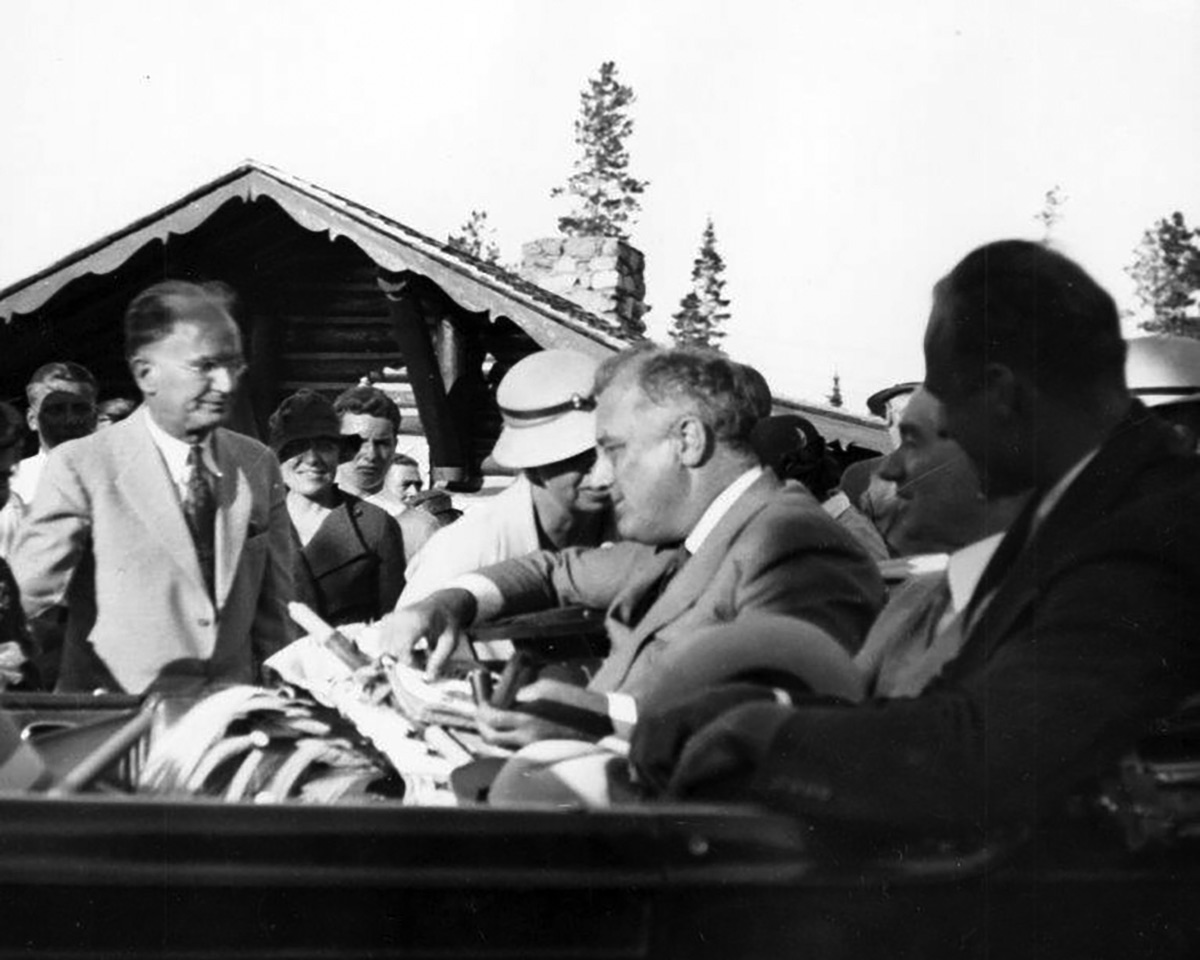
They lunched at Many Glaciers Hotel, before traveling to Two Medicine Chalet, where arrangements had been made for a presidential radio address to the American people in the evening. "Today, for the first time in my life, I have seen Glacier Park. Perhaps I can best express to you my thrill and delight by saying that I wish every American, old and young, could have been with me today. The great mountains, the glaciers, the lakes and the trees made me long to stay here for all the rest of the summer." Secretary Ickes had declared 1934 to be "National Parks Year." The President thought that the phrase "National Parks Year" should apply to every year. After describing some of the government's activities, he said, "We are definitely in an era of building, the best kind of building – the building of great public projects for the benefit of the public and with the definite objective of building human happiness."
A Splendid Working Agreement
During a 1928 address to the American Society of Civil Engineers, Mather called the 1926 NPS-BPR memorandum "a splendid working agreement." BPR's H. K Bishop admitted that initially, BPR's engineers had been "a bit inclined to think too much of economy in road construction and too little of scenic effects," but the lessons from the early years gave BPR "a new appreciation of scenic factors … in the character of the roads built" in National Parks and Forests.
The MOU that Secretary Buttigieg and Secretary Haaland signed was the latest step in the partnership that Stephen T. Mather and Thomas H. MacDonald forged in 1926, as symbolized during a ceremony at a moment in time on July 15, 1933. That partnership remains strong today, as NPS and FHWA's Office of Federal Lands Highway work to keep the National Parks' transportation facilities robust, innovative, and in harmony with the landscape.


Thanks to Timothy Davis for help on this article; Jean Tabbert, Museum & Archives, Glacier National Park; and Sherry Hayman, Graphic Design/Marketing Public Affairs Liaison, Office of Federal Lands Highway, FHWA. References for this article include Davis's National Park Roads: A Legacy in the American Landscape, University of Virginia Press, 2016; America's National Park Roads and Parkways: Drawing from the Historic American Engineering Record by Timothy Davis, Todd A. Croteau, and Christopher H. Marston, The Johns Hopkins University Press, 2004; and "Road Work" by Jessica Wambach Brown, American History, June 2021.
